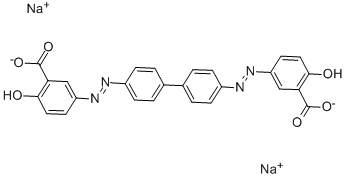CHRYSAMINE G
Synonym(s):4,4′-Bis(3-carboxy-4-hydroxyphenylazo)biphenyl disodium salt;Cathepsin G;CG;CTSG
- CAS NO.:6472-91-9
- Empirical Formula: C26H16N4O6.2Na
- Molecular Weight: 526.41
- MDL number: MFCD00045823
- SAFETY DATA SHEET (SDS)
- Update Date: 2024-12-18 14:07:02

What is CHRYSAMINE G?
The Uses of CHRYSAMINE G
Chrysamine G is a lipophilic derivative of Congo red and a βamyloid inhibitor.
What are the applications of Application
Chrysamine G is a lipophilic derivative of Congo red and a βamyloid inhibitor
Preparation
3-Acetylamino-N,N-diethylaniline double nitriding, and 2-Hydroxybenzoic acid (2 Moore) coupled.
Biochem/physiol Actions
New probe for ?-amyloid aggregates.
Properties and Applications
dark yellow. Soluble in water for lemon yellow, slightly soluble in alcohol. The strong sulfuric acid for quality of red, yellow for shallow diluted olives. The dye solution to join strong hydrochloric acid for yellow light olive; Add thick sodium hydroxide solution into orange (3-Acetylamino-N,N-diethylaniline type). Used for cellulose fiber, wool, silk dyeing, cellulose fiber fabric printing, discharge sex is good, levelness general.
| Standard | Acid Resistance | Alkali Resistance | Light Fastness | Soaping | Water | ||
| Fading | Stain | Fading | Stain | ||||
| ISO | 2-3 | 2 | 4 | 1-2 | 2-3 | ||
Properties of CHRYSAMINE G
| storage temp. | -20°C |
| solubility | DMSO: ~4 mg/mL |
| form | solid |
| color | orange |
| Stability: | Light Sensitive |
| EPA Substance Registry System | C.I. Direct Yellow 1 (6472-91-9) |
Safety information for CHRYSAMINE G
Computed Descriptors for CHRYSAMINE G
New Products
Tert-butyl bis(2-chloroethyl)carbamate (S)-3-Aminobutanenitrile hydrochloride N-Boc-D-alaninol N-BOC-D/L-ALANINOL N-octanoyl benzotriazole 3,4-Dibenzyloxybenzaldehyde 4-Hydrazinobenzoic acid 1,1’-CARBONYLDIIMIDAZOLE R-2-BENZYLOXY PROPIONIC ACID 4-HYDROXY BENZYL ALCOHOL 1,1’-CARBONYLDI (1,2-4 TRIAZOLE) 3-NITRO-2-METHYL ANILINE (2-Hydroxyphenyl)acetonitrile 4-Bromopyrazole 5-BROMO-2CYANO PYRIDINE 5,6-Dimethoxyindanone 5-broMo-2-chloro-N-cyclopentylpyriMidin-4-aMine 2-(Cyanocyclohexyl)acetic acid 4-methoxy-3,5-dinitropyridine 2-aminopropyl benzoate hydrochloride 1-(4-(aminomethyl)benzyl)urea hydrochloride tert-butyl 4- (ureidomethyl)benzylcarbamate diethyl 2-(2-((tertbutoxycarbonyl)amino) ethyl)malonate Ethyl-2-chloro((4-methoxyphenyl)hydrazono)acetateRelated products of tetrahydrofuran






![Benzoic acid, 2-hydroxy-5-[[4-(6-methyl-7-sulfo[2,6'-bibenzothiazol]-2'-yl)phenyl]azo]-, disodium salt](https://img.chemicalbook.in/CAS/20200401/GIF/6408-88-4.gif)

You may like
-
 Chrysamine G CAS 6472-91-9View Details
Chrysamine G CAS 6472-91-9View Details
6472-91-9 -
 55441-95-7 99%View Details
55441-95-7 99%View Details
55441-95-7 -
 N-Vinylformamide 99%View Details
N-Vinylformamide 99%View Details
13162-05-5 -
 Chloro Uracil 1820-81-1 99%View Details
Chloro Uracil 1820-81-1 99%View Details
1820-81-1 -
 207557-35-5 99%View Details
207557-35-5 99%View Details
207557-35-5 -
 2-ethyl-6-methyl-3-hydroxypyridine succinate 99%View Details
2-ethyl-6-methyl-3-hydroxypyridine succinate 99%View Details
127464-43-1 -
 2-ETHYLPYRIDINE 100-71-0 99%View Details
2-ETHYLPYRIDINE 100-71-0 99%View Details
100-71-0 -
 181228-33-1 (S)-Methyl 3-amino-2-((tert-butoxycarbonyl)amino)propanote Hydrochloride (DAP-OMe. HCl) 99%View Details
181228-33-1 (S)-Methyl 3-amino-2-((tert-butoxycarbonyl)amino)propanote Hydrochloride (DAP-OMe. HCl) 99%View Details
181228-33-1
Statement: All products displayed on this website are only used for non medical purposes such as industrial applications or scientific research, and cannot be used for clinical diagnosis or treatment of humans or animals. They are not medicinal or edible.